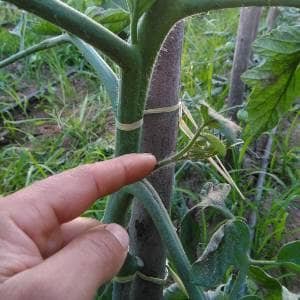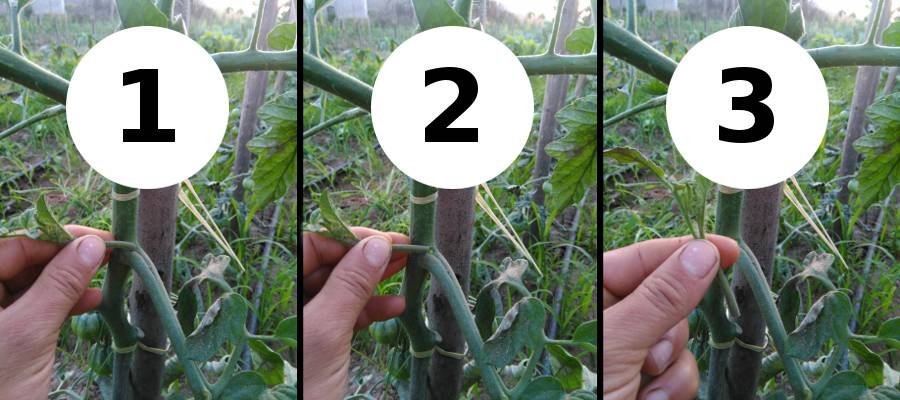Pruning or trimming indeterminate tomato plants
Warning: Undefined variable $ad_top in /home/u376105422/domains/mundohuerto.com/public_html/main-html-en.php on line 91
Warning: Undefined variable $ad_article in /home/u376105422/domains/mundohuerto.com/public_html/main-html-en.php on line 124
Warning: Undefined variable $ad_into_article in /home/u376105422/domains/mundohuerto.com/public_html/main-html-en.php on line 153
Warning: Undefined variable $ad_into_article_full in /home/u376105422/domains/mundohuerto.com/public_html/main-html-en.php on line 154
Warning: Undefined variable $ad_inter_item in /home/u376105422/domains/mundohuerto.com/public_html/main-html-en.php on line 155
To begin this article on tomato pruning, we must clarify that not all varieties are pruned, or not pruned with the same intensity and in the same way.

In the varieties of indeterminate growth, pruning is essential to control their growth and favor aeration, sun exposure and the size of the fruit. On the other hand, in determinate ones, more pruning is not usually carried out than is necessary to maintain correct aeration and health of the plants or improve the quality of the fruits.
If you are not clear about these concepts, here is an article that explains them in a simple way.
All pruning operations should preferably be done when humidity conditions are lower, normally in the afternoon, avoiding doing them with wet plants or just before it rains.
Pruning in indeterminate varieties
Depending on whether axillary shoots, leaves, flowers, fruits or the apical shoot are removed, we will be talking about formation pruning and trimming, leaf removal, flower tipping, fruit thinning or plant tipping.
Pruning axillary shoots
 Pic 1. Detail of an axillary shoot or sucker on a tomato plant.
Pic 1. Detail of an axillary shoot or sucker on a tomato plant.15 or 20 days after transplanting the tomato plants, shoots with lateral growth begin to grow in the axils of the leaves which, if not pruned, would form new stems that would take up too much space and compete with the main one for light and plant resources. soil, making the fruits smaller. In addition, the aeration of the plants would be very difficult, increasing the risk of suffering from diseases.
These axillary shoots are removed as soon as possible, once they can be caught, since the more they grow, the greater the wound that will be left on the plant and the risk of infection increases.
In addition, the energy and resources that the plant spent to develop that shoot will have been lost and could have been used to fatten the fruits or produce new leaves.
In favorable conditions (summer) this pruning must be done weekly or even a couple of times a week if necessary. The rest of the year, with lower temperatures, it can be done every 2 weeks, since growth will be slower.
Regarding the procedure to follow to eliminate axillary shoots or suckers, the following photograph describes it perfectly. If done on time, no tools will be required as the buds come off easily when pulled with your fingers.
 Pic 2. Process of pruning small axillary shoots.
Pic 2. Process of pruning small axillary shoots.These axillary shoots root easily if planted in a substrate for cuttings or seedlings, giving rise to a new plant that can be used to replace a diseased one or as a gift.
For shoots that have grown too much, a well-sharpened and disinfected razor or knife must be used to make the cut, since if we try to do it by pulling by hand, it is possible that a significant tear will occur through which pathogens could enter.
Nor is it convenient to prune when the sprout is very small, since it will be difficult to grasp between the fingers and when pulled it will not come off through the area where it joins the armpit, but a little higher up, leaving a stump that will remain. It can be a source of infections.
Leaf pruning or defoliation
Leaf pruning is done with three fundamental objectives: improve aeration, remove old or diseased leaves, and favor fruit ripening.
In addition to the old leaves closest to the ground, the leaf on top of each fruit bunch is usually removed, unless it is necessary to support the top bunch.
Avoid pruning the leaf located in front of each bouquet of fruits since it is the one that provides the most nutrients to them.
As for the rest of the leaves, it is preferable to remove those less exposed to the sun; North and East orientation (in the Northern hemisphere), especially in times of low solar radiation.
It will be a question of not removing more than 3 leaves per plant in each pruning operation since removing more could cause imbalances in the tomato plant.
Trimming or pruning of the apical bud
It consists of cutting the apical shoot of the plant to stop its growth and concentrate resources on fattening and ripening the tomatoes. One or two leaves are left above the last floral cluster, which will be in charge of feeding and shading that last bouquet.
This pruning is done when it is considered that the plant will no longer have time to ripen new fruits. In the hot season, freshly set tomatoes will take about 1.5 months to ripen while in the cold season they will need about 3 months. Taking these data into account, the best moment to make the blunting can be programmed quite correctly.
Flower pruning
In the professional cultivation of bunch tomato varieties, some flowers are usually removed from each bunch to leave only 6 or 7 fruit set per bunch. This improves the quality, size and homogeneity of the tomatoes.